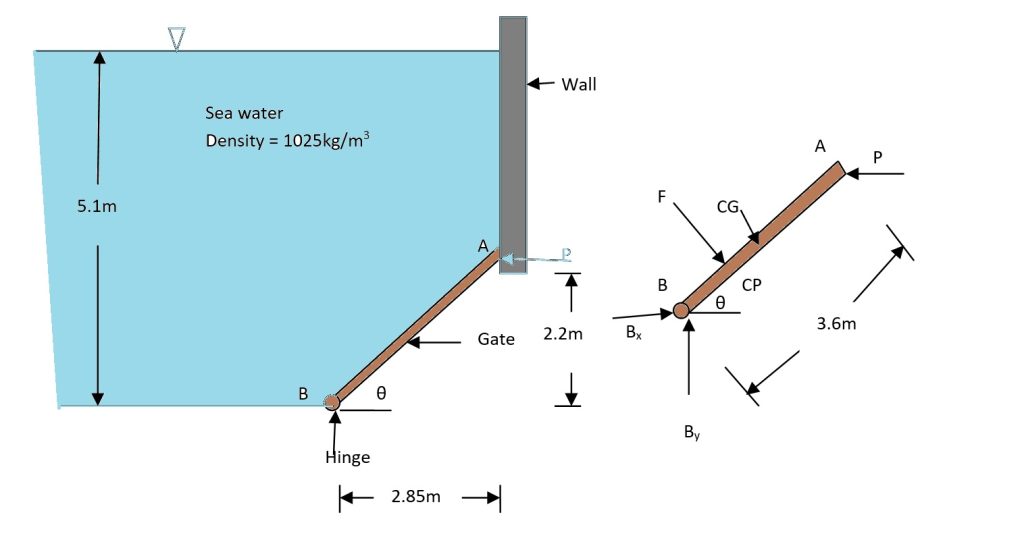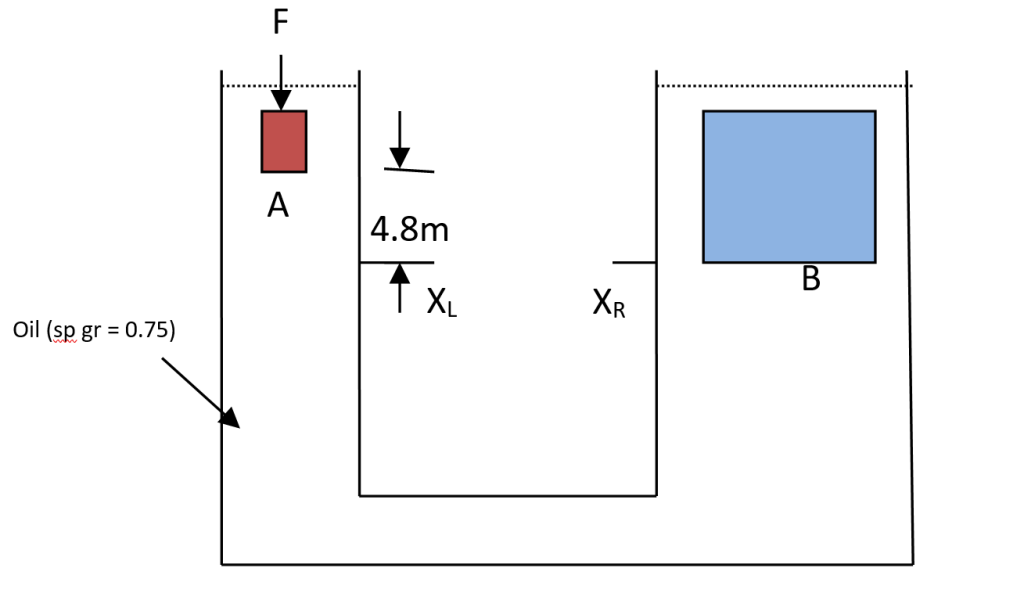
Problem Statement
A cylinder, 2m in diameter and 3m long, weighing 3 kN, rests on the floor of a tank. It has water to a depth of 0.6 m on one side and a liquid of specific gravity 0.7 to a depth of 1.25 m on the other side. Determine the magnitude and direction of the horizontal and vertical components of the force required to hold the cylinder in position.
Solution
1. Geometry of the Cylinder
Given:
\( OA = OB = OC = 1 \, \text{m} \)
\( BD = 0.6 \, \text{m} \)
\( OD = 1 – 0.6 = 0.4 \, \text{m} \)
\( CD = \sqrt{1^2 – 0.4^2} = 0.9165 \, \text{m} \)
\( \angle COD = \tan^{-1}\left(\frac{0.9165}{0.4}\right) = 66.40^\circ \)
\( OE = 1.25 – 1 = 0.25 \, \text{m} \)
\( \angle AOE = \cos^{-1}\left(\frac{0.25}{1}\right) = 75.50^\circ \)
\( \angle AOB = 180^\circ – 75.5^\circ = 104.50^\circ \)
\( AE = 0.25 \tan(75.5^\circ) = 0.96 \, \text{m} \)
2. Weight of the Cylinder
\( \text{Weight of cylinder} = 3 \, \text{kN} = 3000 \, \text{N} \)
3. Net Horizontal Force \( F_H \)
\( F_H = (F_H)_{AB} – (F_H)_{CB} = \gamma_{\text{oil}} A_1 \bar{y_1} – \gamma A_2 \bar{y_2} \)
\( F_H = 0.7 \times 9810 \times 1.25 \times 3 \times \frac{1.25}{2} – 9810 \times 0.6 \times 3 \times \frac{0.6}{2} \)
\( F_H = 10797 \, \text{N (left)} \)
4. Net Vertical Force \( F_V \)
\( F_V = \text{Weight of volume of oil above AB} + \text{Weight of volume of water above BC} \)
\( F_V = \gamma_{\text{oil}} (\text{Volume of sector AOB} + \text{Volume of } \Delta AOE) + \gamma (\text{Volume of sector BOC} – \text{Volume of } \Delta COD) \)
\( F_V = 9810 \times 0.7 \left(\frac{104.5}{360} \times \pi \times 1^2 \times 3 + 0.5 \times 0.25 \times 0.96 \times 3\right) + 9810 \left(\frac{66.4}{360} \times \pi \times 1^2 \times 3 – 0.5 \times 0.9165 \times 0.4 \times 3\right) \)
\( F_V = 32917 \, \text{N (up)} \)
5. Resultant Force Components
The components to hold the cylinder in place are:
\( F_H = 10797 \, \text{N (to the right)} \)
\( F_V = 32917 – 3000 = 29917 \, \text{N (down)} \)
Detailed Explanation
This problem involves calculating the forces acting on a cylinder due to fluids on either side. Here’s a step-by-step breakdown:
- Geometry of the Cylinder: The dimensions and angles are calculated to determine the areas and volumes of fluid above the cylinder. This includes calculating the lengths and angles using trigonometric relationships.
- Horizontal Force: The net horizontal force is the difference between the forces exerted by the oil and water. The force due to each fluid is calculated using the formula \( F = \gamma A \bar{y} \), where \( \gamma \) is the specific weight, \( A \) is the area, and \( \bar{y} \) is the depth of the centroid.
- Vertical Force: The net vertical force is the sum of the weights of the oil and water above the cylinder. This involves calculating the volumes of the sectors and triangles formed by the fluid surfaces and the cylinder.
- Resultant Force: The horizontal and vertical forces are combined to determine the resultant force required to hold the cylinder in place. The direction of the resultant force is also calculated using trigonometric relationships.
Physical Meaning
The problem demonstrates the application of fluid statics principles to determine the forces acting on a submerged object. Here’s the practical significance:
- Hydrostatic Forces: The forces exerted by fluids on surfaces depend on the fluid’s specific weight, the area of the surface, and the depth of the centroid. These forces are crucial in designing structures like dams, tanks, and pipelines.
- Equilibrium of Forces: To hold the cylinder in place, external forces must balance the hydrostatic forces. This ensures stability and prevents movement of the cylinder.
- Importance of Geometry: The shape and orientation of the submerged object significantly influence the magnitude and direction of the forces. Understanding these geometric relationships is essential for accurate calculations.



